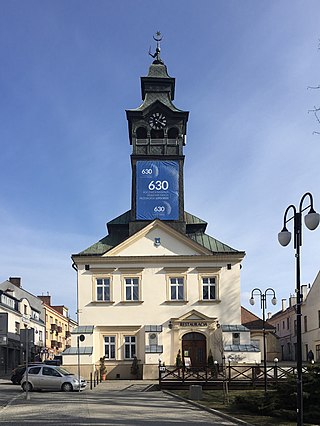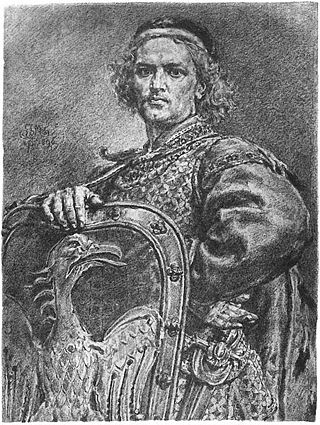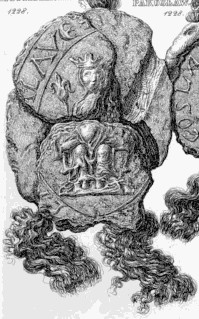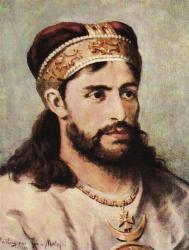
Red Ruthenia, or Red Rus' , is a term used since the Middle Ages for the south-western principalities of the Kievan Rus', namely the Principality of Peremyshl and the Principality of Belz. Nowadays the region comprises parts of western Ukraine and adjoining parts of south-eastern Poland. It has also sometimes included parts of Lesser Poland, Podolia, Right-bank Ukraine and Volhynia. Centred on Przemyśl and Belz, it has included major cities such as: Chełm, Zamość, Rzeszów, Krosno and Sanok, as well as Lviv and Ternopil.

The Ruthenian Voivodeship, also called Rus’ voivodeship, was a voivodeship of the Crown of the Kingdom of Poland from 1434 until the 1772 First Partition of Poland with a center in the city of Lviv. Together with a number of other voivodeships of southern and eastern part of the Kingdom of Poland, it formed Lesser Poland Province, with its capital city in Kraków. Following the Partitions of Poland, most of Ruthenian Voivodeship, except for its northeastern corner, was annexed by the Habsburg monarchy, as part of the province of Galicia. Today, the former Ruthenian Voivodeship is divided between Poland and Ukraine.

Galicia is a historical and geographic region spanning what is now southeastern Poland and western Ukraine, long part of the Polish–Lithuanian Commonwealth. It covers much of the other historic regions of Red Ruthenia and Lesser Poland.

The Principality or, from 1253, Kingdom of Galicia–Volhynia, historically known as the Kingdom of Ruthenia, was a medieval state in Eastern Europe which existed from 1199 to 1349. Its territory was predominantly located in modern-day Ukraine, with parts in Belarus, Poland, Moldova, and Lithuania. Along with Novgorod and Vladimir-Suzdal, it was one of the three most important powers to emerge from the collapse of Kievan Rus'. The main language was Old East Slavic, the predecessor of the modern East Slavic languages, and the official religion was Eastern Orthodoxy.

Przeworsk is a town in south-eastern Poland with 15,675 inhabitants, as of 2 June 2009. Since 1999 it has been in the Subcarpathian Voivodeship, and is the capital of Przeworsk County. The ancient Przeworsk culture was named after the town.

Leszek the White was Prince of Sandomierz and High Duke of Poland in the years 1194–1198, 1199, 1206–1210, and 1211–1227. During the early stages of his reign, his uncle Duke Mieszko III the Old and cousin Władysław III Spindleshanks, from the Greater Polish branch of the royal Piast dynasty, contested Leszek's right to be High Duke.

Konrad I of Masovia, from the Polish Piast dynasty, was the sixth Duke of Masovia and Kuyavia from 1194 until his death as well as High Duke of Poland from 1229 to 1232 and again from 1241 to 1243.

Michael or Mikhail of Chernigov or Mikhail Vsevolodovich ; c. 1185 – 20 September 1246) was Grand Prince of Kiev ; he was also Prince of Pereyaslavl (1206), Prince of Novgorod-Seversk (1219–1226), Prince of Chernigov, Prince of Novgorod, and Prince of Galicia (1235–1236).

Daniel of Galicia or Danylo Romanovych was a King of Ruthenia, Prince (Kniaz) of Galicia (Halych) (1205–1255), Peremyshl (1211), and Volodymyr (1212–1231). He was crowned by a papal archbishop in Dorohochyn in 1253 as the first King of Ruthenia (Rus') (1253–1264).

Roman Mstislavich, also known as Roman the Great, was a Rus’ prince and a member of Izyaslavichi of Volhynia clan. He founded the Romanovichi dynasty, which would rule Volhynia and Halych until 1340.

The Principality of Halych, or Principality of Halychian Rus', was a medieval East Slavic principality, and one of the main regional states within the political scope of Kievan Rus', established by members of the oldest line of Yaroslav the Wise descendants. A characteristic feature of the Halych principality was the important role of the nobility and citizens in political life, and consideration a will which was the main condition for the princely rule. Halych as the capital mentioned in around 1124 as a seat of Ivan Vasylkovych the grandson of Rostislav of Tmutarakan. According to Mykhailo Hrushevsky the realm of Halych was passed to Rostyslav upon the death of his father Vladimir Yaroslavich, but he was banished out of it later by his uncle to Tmutarakan. The realm was then passed to Yaropolk Izyaslavich who was a son of the ruling Grand Prince Iziaslav I of Kiev.

Coloman of Halych was the ruler—from 1214 prince, and from 1215 or 1216 to 1221 king—of Halych, and duke of Slavonia from 1226 to his death. He was the second son of Andrew II of Hungary and Gertrude of Merania. His father and Leszek the White, Duke of Poland, concluded an agreement about the marriage of Coloman and Leszek's daughter, Salomea, and the division of Halych, allotting its western regions to Leszek, the remaining lands to Coloman. The Hungarian and Polish armies occupied the principality in late 1214. Andrew II appointed a Hungarian nobleman, Benedict the Bald, to administer it on Coloman's behalf. Coloman was crowned the first king of Halych with the pope's authorization in early 1216.
Boroldai, also known as Burundai, was a notable Mongol general of the mid 13th century. He participated in the Mongol invasion of Russia and Europe in 1236-1242 and other Mongol raids to Europe until 1263.

The Mongol Invasion of Poland from late 1240 to 1241 culminated in the Battle of Legnica, where the Mongols defeated an alliance which included forces from fragmented Poland and their allies, led by Henry II the Pious, the Duke of Silesia. The first invasion's intention was to secure the flank of the main Mongolian army attacking the Kingdom of Hungary. The Mongols neutralized any potential help to King Béla IV being provided by the Poles or any military orders.

Siemowit I of Masovia, was a Polish prince member of the House of Piast, Duke of Czersk during 1247–1248, Duke of Masovia during 1248–1262, ruler over Sieradz during 1259–1260.

Grzymisława Ingvarevna of Łuck was a Princess of Kraków, daughter of Ingvar of Kiev, Grand Prince of Kiev and Prince of Lutsk from the Monomakhovichi.
With the arrival of the Hungarians into the heart of the Central European Plain around 899, Slavic tribes of Vistulans, White Croats, and Lendians found themselves under Hungarian rule. In 955 those areas north of the Carpathian Mountains constituted an autonomous part of the Duchy of Bohemia and remained so until around 972, when the first Polish territorial claims began to emerge. This area was mentioned in 981, when Vladimir the Great of Kievan Rus' claimed the area on his westward way. In the 11th century the area belonged to Poland, then reverted to Kievan Rus'. However, at the end of the 12th century the Hungarian claims to the principality turned up. Finally Casimir III of Poland annexed it in 1340–1349. Low Germans from Prussia and Middle Germany settled parts of northern and western Galicia from the 13th to 18th centuries, although the vast majority of the historic province remained independent from German and Austrian rule.

The third Mongol invasion of Poland was carried out by Talabuga Khan and Nogai Khan in 1287–1288. As in the second invasion, its purpose was to loot Lesser Poland, and to prevent Duke Leszek II the Black from interfering in Hungarian and Ruthenian affairs. The invasion was also part of the hostilities between Poland and Ruthenia; in 1281, the Poles had defeated a Mongol force near Goslicz which had entered Duke Leszek's territory in support of Lev I.
The Metropolis of Halych was a metropolis of the Ecumenical Patriarchate of Constantinople in the Eastern Orthodox Church. It was erected on the territory of the Kingdom of Galicia–Volhynia in 1303 by Patriarch Athanasius I of Constantinople. The episcopal seat of the metropolis was in the city of Halych in the "Cathedral of the Assumption".

The War for Brest was Prince Casimir II the Just's military campaign against Kievan Rus following the fall of Brest. Casimir quickly captured the city and made efforts to restore Prince Mstislav to the throne of Halych. Despite initial reluctance from some Polish lords, Casimir led his forces into battle against opposing Rus princes. The engagement culminated in a decisive victory for Casimir, resulting in the surrender of Ruthenians and the restoration of Mstislav to the throne.



















